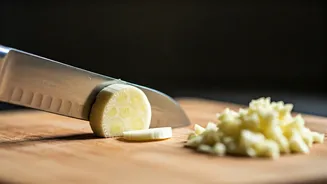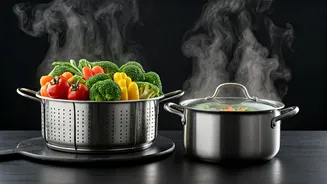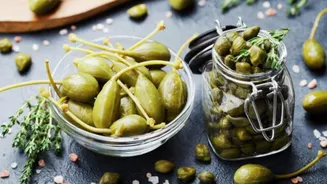Crushing Garlic: Simply Done
Crushing garlic is the quickest and easiest method, perfect when you want a strong, immediate garlic flavor. To crush garlic, place a clove on a flat surface,
like a cutting board, and use the flat side of a chef's knife to firmly press down. The garlic clove bursts open, releasing its oils and fragrance. Crushed garlic works well when added to sauces, marinades, or sautéed directly in oil. It provides an intense garlic punch that quickly infuses the dish. Remember, crushing releases enzymes that contribute to its pungency, so it's a great choice for recipes where a bold garlic flavor is desired without precise cutting.
Minced Garlic: Fine Texture
Mincing garlic involves chopping it into tiny, irregular pieces, ideal for recipes where garlic needs to blend seamlessly into a dish. This technique releases a lot of the flavor and aroma. To mince garlic, start by peeling the cloves. Then, use a sharp knife to finely chop the garlic into small pieces. You can also use a garlic press for a similar result, although this can sometimes leave a slightly bitter aftertaste. Minced garlic is suitable for everything from stir-fries and pasta sauces to dressings, as it spreads the garlic flavor evenly throughout. The finer the mince, the faster the garlic flavor will integrate into your dish.
Slicing Garlic: Elegant Thinness
Slicing garlic creates thin, uniform pieces, ideal for achieving a more subtle garlic flavor and an aesthetically pleasing presentation. To slice garlic, peel the clove and lay it flat on the cutting board. Then, use a sharp knife to carefully cut the clove into thin slices. Sliced garlic is beautiful when sautéed in olive oil, where it can become golden and crispy, adding a delicate garlic flavor to dishes like pasta or salads. It can also be used as a topping for pizzas or added to soups for a touch of elegance. The key is to cut uniform slices for even cooking.
Dicing Garlic: Uniform Cubes
Dicing garlic involves cutting it into small, uniform cubes, which provides a balance between the texture of sliced garlic and the intensity of minced garlic. To dice garlic, start by slicing the clove lengthwise, then crosswise, creating small cubes. Diced garlic works well in dishes where you want to see and taste the garlic, such as in stews, braises, or chunky sauces. The uniform size of the dice allows for even cooking and flavor distribution. It's a great technique if you want the garlic to be noticeable in a dish without overpowering other ingredients.
Chopping Garlic: Rough Cuts
Chopping garlic involves a more freeform method of breaking down garlic cloves into irregular pieces. It’s perfect when you want a rustic appearance or a less concentrated garlic flavor. To chop garlic, roughly cut the cloves into smaller pieces without aiming for precise uniformity. Chopped garlic works well in quick-cooking dishes or when you want the garlic to retain some of its texture. It’s suitable for sautéing vegetables, adding to stir-fries, or in dishes where a rough texture is desired. The irregular pieces release flavor more slowly, offering a more mellow garlic experience.
Smashing Garlic: Intense Flavors
Smashing garlic involves crushing the cloves with the side of your knife, similar to crushing, but with the aim of breaking the garlic into larger pieces rather than a fine texture. This method is often used to release the flavor before cooking. To smash garlic, place the clove on a cutting board and press down firmly with the side of a chef's knife. Smashing is suitable for dishes where you want to infuse a sauce or oil with garlic flavor without actually eating the garlic pieces, such as in a flavorful garlic-infused oil. The smashed cloves release their flavor gradually during cooking.
Microplaning Garlic: Fluffy Texture
Microplaning garlic results in a fluffy, almost cloud-like texture, perfect for distributing garlic flavor evenly throughout a dish. This technique grates garlic into tiny pieces. To microplane garlic, use a microplane grater to grate the peeled garlic cloves. The resulting garlic is light and airy, ideal for incorporating into sauces, dressings, and toppings. Microplaned garlic infuses flavor quickly and evenly, without the textural presence of chopped garlic. It's especially useful for raw applications, where you want a smooth texture and the full flavor of fresh garlic.













